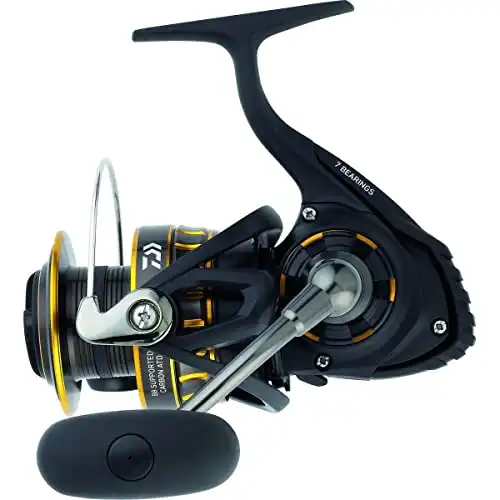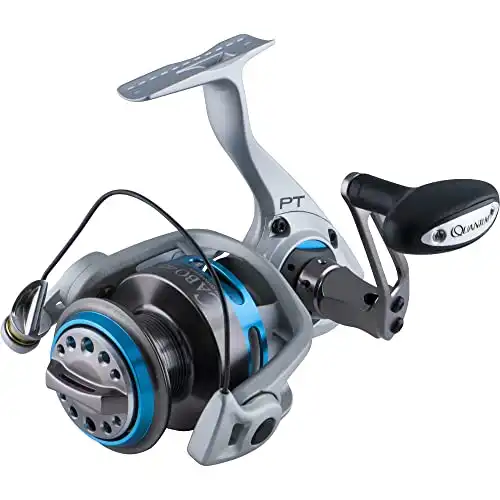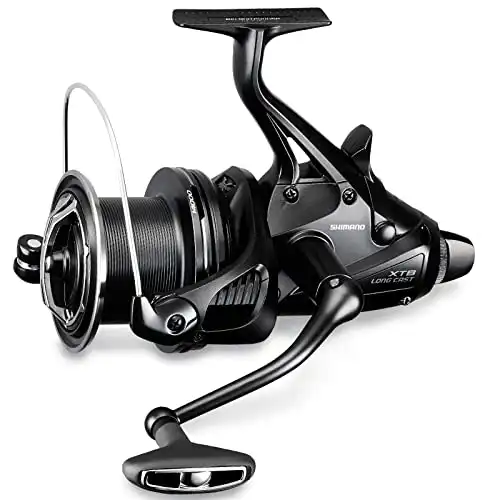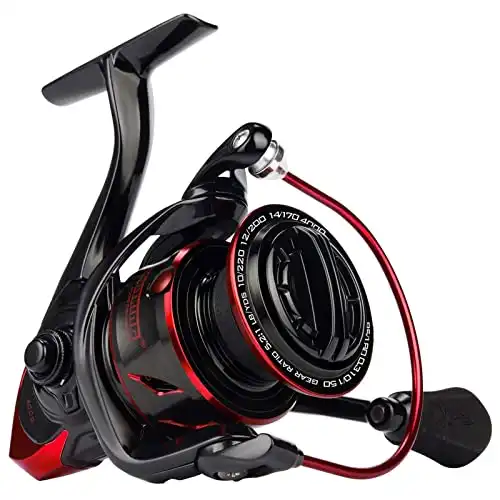
Searching for the best surf fishing reels?
We’ve broken down the best surf fishing reels from all the top manufacturers to find what we consider to be the top seven for their price, construction, ease of use, and dependability. With that said, our overall winner is the Penn Battle II Spinning Reel. It provides everything you need for a surf fishing reel, including strength, durability, and ease of use.
The 8000 series is a brute, and when coupled with a 9-6 Mojo Musky Rod you have a shorter, more powerful combination, that still features a very smooth action with the six-ball bearing Penn design.
The best surf fishing reel really depends on what you are targeting. If you’re just after sea perch, a larger reel isn’t necessary. If you want to bring in some lingcod or rockfish, you will need a stronger reel that can handle the strength of a formidable fish.
Here are the seven best surf fishing reels, as chosen by our team.
- Penn Battle II Spinning Reel – Best Overall
- Daiwa BG8000 BG Saltwater Spinning Reel – Most Affordable
- Penn Spinfisher VI Spinning Reel – Overall great reel
- Penn Slammer III Spinning Reel – Rugged and Reliable
- Quantum Cabo Saltwater Spinning Fishing Reel – Premium Reel
- Shimano Ultegra XTD Surf Reel – High-Quality
- KastKing Sharky III Fishing Reel – Best Budget Reel
Best Surf Fishing Reels Reviewed
Penn Battle II Spinning Reel
- Weight: 12.4 ounces
- Gear Ratio: 6.2:1
- Bearings: 5+1
The Penn Battle II is a fantastic reel. Sealed bearings keep the water and sand out, keeping the reel in top working order with minimal maintenance. Fighting saltwater giants from the beach just got a bit easier with this reel. The anti-reverse setting stops any line slack eliminating pullback from big fish. The drag is sensitive and strong, with treated drag washers that ensure longevity.
The full metal body keeps the saltwater at bay; just a rinse will have the reel ready for the next trip. The metal spool has a rubber gasket to hold the braided line and Spiderwire Superline without slippage. No monofilament backing is necessary.
The spool has three line capacity rings, which allow you to see how much line is out by a quick glance. That comes in very handy when you’re hooked into a monster fish that keeps pulling line.
The price of this reel may be a bit higher than the budget angler wants to spend. Still, overall, the high quality and durability make this a reel that will last for years to come.
Daiwa BG8000 BG Saltwater Spinning Reel
- Weight: 12.4 ounces
- Gear Ratio: 5.6:1
- Bearings: 6+1
The Daiwa BG Saltwater is an excellent reel with an affordable entry price. The drag is waterproof, with the implementation of a high-quality carbon ATD drag system. The body and side cover are made from industrial grade HardBodyz material to provide the maximum amount of strength and durability.
Fishing with the BG is a fun experience. The reel is super smooth, easy to cast, and offers premium features in a budget price range. The larger saltwater spinning reels, above 4500, provide a 33-pound drag and an infinite dual anti-reverse clutch system. No more losing fish because the line slipped on the hookset.
The spool is dynamically cut aluminum. The reel features a breathable air rotor that cuts a significant amount of weight from the reel. Test it out yourself and share your thoughts with us.
Penn Spinfisher VI Spinning Reel
- Weight: 12.16 ounces
- Gear Ratio: 6.2:1
- Bearings: 5+1
The Penn Spinfisher VI Spinning Reel is almost the perfect choice for the beginner surf angler. The only real drawback is the price point. This reel can handle even the roughest seas, biggest fish, and most beginner mistakes (like dropping it in the ocean, laying it in the sand, etc.) Hook up to a big cod or a ray, and you’ll find out right away how responsive and tough this reel is.
The drag is spectacular, with carbon fiber drag washers included ensuring it doesn’t slip or lock up. The sealed bearings mean less worry of saltwater and sand getting inside the reel housing. The handle can be interchanged from right to left-handed as needed.
Instant anti-reverse kicks in at the first touch of a bite, keeping the line from slackening at all. Hookups are solid. Give this reel a try if you are able to meet the higher price point.
Penn Slammer III Spinning Reel
- Weight: 11.99 ounces
- Gear Ratio: 5.2:1
- Bearings: 6+1
The Slammer 3 is a solid choice for a surf reel. Built like a tank, this reel feels like it’s indestructible. A sealed main body, sealed bearings, and all-metal construction keep this reel in great shape trip after trip.
Penn has included the proprietary Dura-Drag system on this model, with the larger 9500 and 10500 models going up to a full 60-pounds of smooth drag. That will stop pretty much everything but a bus. The sealed bearings and body keep it free of saltwater and sand, making it a perfect choice for surf fishing.
The 2016 ICAST awards ranked this reel the Best Saltwater Reel of the year. That says something for it.
The best part of this exceptionally durable reel is the ability to last for years with basic care. You can have a reel that will cast like new after five years if you maintain it well. It’s a very high-quality reel and will keep you in fish for a long time.
Quantum Cabo Saltwater Spinning Fishing Reel
- Weight: 13.4 ounces
- Gear Ratio: 5.3:1
- Bearings: 7+1
The Quantum Cabo line of saltwater reels has an all-aluminum body and a titanium bail with a magnetic trip. It has the durability and muscle to handle most of what the surf has to offer. The reel has proprietary saltguard technology to keep it from corroding, and the bearings are protected with anti-corrosion coating.
A super-smooth retrieve and anti-reverse clutch make for immediate hook sets without any line slippage. Take this reel to the beach and spend the day catching everything from sea perch to barracudas. The reel will do the work, and if it fails, Quantum has a 5-year warranty on defects and material issues.
Shimano Ultegra XTD Surf Reel
- Weight: 17.3 ounces
- Gear Ratio: 5.3:1
- Bearings: 3+1
The Ultrega XTD Surf Reel is a high-quality, durable outfit that will last for years to come. Newly designed to move the center of gravity closer to the fishing rod, this reel intends to be used for hours on end with little fatigue in the angler.
The body is designed to line up at precisely 90° to the first eyelet on the rod. This eliminates line slap and makes casting smoother. This ties in with the new Propulsion Line Management System. Shimano has tested and perfected a new spool lip design to allow for greater line capacity, longer casts with less drag, and backlashes.
Instant drag makes adjusting drag in real-time easy and effective. A quick turn of the drag can take it from moderate drag to wide open. Take this reel out to the shore and give it a go. You’ll find it to be well worth the money.
KastKing Sharky III Fishing Reel
- Weight: 10.2 ounces
- Gear Ratio: 5.2:1
- Bearings: 10+1
The KastKing Sharky III is a great reel for the price. The number of bearings on this thing keeps it moving smoothly. A smooth drag of up to 39.5 pounds is unheard of on such an inexpensive reel. That strength makes landing bigger fish a possibility time and again. Targeting saltwater fish with this reel couldn’t be easier. Just remember to rinse with freshwater when you’re done to avoid corrosion.
The bearings aren’t completely sealed, meaning they are “shielded” from water and sand but not completely protected. That can come to a head if you haven’t been maintaining the reel diligently after each use. Rinse and oil it regularly to avoid any issues.
The bail might hit the top of the reel if the spool is at the top, but this is a minor inconvenience based on the price. Keep an eye on it, and you should be fine. Keep in mind that the components of this reel aren’t as high-quality as the more expensive saltwater spinning reels on this list, so more maintenance is required to keep its handling at a high level.
Buyers Guide
What options should you look for when buying a surf fishing reel? Let’s break down what to consider:
- How much line capacity do you need for the species you’re targeting?
- How much do you want to spend?
- How often are you fishing?
Targeting sea perch in the surf isn’t the same as targeting sharks or rays in the surf. If you’re going for smaller fish, a smaller reel that will hold 300 – 400 yards of 25lb braid should be fine. However, if you are targeting larger fish like sharks, you’ll want a minimum of 550 yards of 50lb braid. That will allow the fish to make several runs without spooling you. A five-foot-long blacktip reef shark can quickly run off with several hundred feet of line before tiring. If you aren’t set up for that, it can lead to a very bad day of saltwater fishing.
Are you interested in buying the top-of-the-line premium reel, or are you looking for a budget-friendly model? Do your research of the model you are interested in and determine if it’s worth the asking price. Not all budget models are made equally, so sift through the reviews and decide for yourself the best route to take. If all else fails, your local tackle shop will help out. They won’t steer you wrong.
Are you planning on using the reel every weekend, or far less often? The amount you plan on using the reel should also factor into the price you are willing to pay. If you only fish once every few months, why bother getting the premium reel? Pick up a budget-friendly reel and take care of it. Speaking of reel maintenance, that brings us to the next topic.
Maintaining your surf fishing reel is of vital importance. Saltwater corrodes metal faster than you might think. As a young angler, I fished the surf in Pensacola, Florida. I was new to surf fishing, and as such, failed to rinse my reel after the first use. When I retrieved my setup to go again, the bail had sizeable spots of corrosion on it, making the reel practically useless. Lesson learned. I always rinse my fishing reels in freshwater to remove any leftover salt and sand that may have stuck to the body. I also clean the fishing rod itself to make sure no corrosion takes place on the eyelets.
Be sure to regularly oil your bearings, if applicable. Don’t neglect your reel, and it will treat you well for several seasons.
Frequently Asked Questions
Spinning Reel vs Conventional Reel For Surf Fishing
Choose a spinning reel. Straight up.
There isn’t much of a debate over which is the better type of reel to use, but we will still break down both the spinning reels and conventional reels. Both have their pros and cons, so it can be hard to decide which one is right for you. Here are some of the key differences between these two types of reels:
Spinning Reel
Spinning reels are a popular choice for anglers who are looking to catch smaller fish. It is a lightweight and easy-to-use reel that is perfect for beginners. A surf fishing spinning reel also offers more control than the conventional reel, which makes it a good choice for inexperienced anglers.
Conventional Reel
The conventional reel is a more traditional type of reel that is favored by anglers who are looking to catch larger fish. It is a heavier and more difficult-to-use reel, but it offers more power and control than spinning reels. The conventional reel is a better choice for offshore trolling as opposed to surf fishing. Go with a spinning reel for all of your surfcasting trips.
When to Use Braided Line for Surf Fishing?
There is no definitive answer to this question as it depends on a variety of factors. However, braided line is often a good choice for surf fishing because it is strong and durable. It can also handle heavier weights, making it ideal for casting into the surf. Braided line is also less likely to tangle than monofilament line, which can be a major advantage when fishing in choppy water.
However, there are some drawbacks to using braided line. It is more expensive than monofilament line, and it can be more difficult to work with. It is also less forgiving if you make a mistake while casting, so it may not be the best choice for novice anglers. Overall, a braided line is a good option for surf fishing, but it is important to consider your individual needs and preferences before making a decision.
Surf Fishing Reel Brakes
When fishing from the surf, you will need a reel with a brake. A brake reel will help to keep the line from spooling off the reel too quickly. If there is no brake on your reel, the line can easily be pulled from the reel by the waves and wind. This can cause you to lose your fish and your bait.
Centrifugal Brake
There are several types of brake systems available on reels. The most common type is the centrifugal brake. This brake system uses a spinning weight to apply pressure to the brake pads. As the spool spins faster, the weight moves outwards and applies pressure to the pads. This slows down the spooling of the line.
Magnetic and Caliper Brakes
Other brake systems include the magnetic brake and the caliper brake. The magnetic brake uses magnets to apply pressure to the brake pads. This system is not as common as the centrifugal brake. The caliper brake uses a set of pads that clamp down on the spool, slowing it down. This type of brake is not common on surf fishing reels.
When choosing a reel with a brake, be sure to choose one that is compatible with the type of line you are using. Brakes are available for both a spinning and baitcasting reel. Be sure to read the instructions carefully to make sure you are using the brake properly. Improper use of the brake can actually cause more problems than it solves.
A brake on your surf fishing reel is a must-have for preventing line loss. This simple device can save you time, effort, and most importantly, fish. Make sure to choose the right brake for your reel and use it properly to get the most out of your saltwater fishing experience.
What Size Reel is Best for Surf Fishing?
On a surf rod, you will find that most people have used a 5:1 spinning reel, which will get the job done. However, it has been my experience that this size is best suited for larger fish (10lb or more). The best reel for smaller fish would be 4:1 gear ratios.
If you’re using bait such as pilchards or mullet, the best options would be a 7:1 or 8:1 spinning reel.
I used to fish with an 8:1 reel and it was great for catching those small but consistent bites. But if you’re after monster fish then a 5:1 is best suited. Keep in mind that bigger surf reels are best suited for bigger fish, and you will need to replace the line as it gets worn down. You will also want to consider line capacity when choosing a saltwater surf fishing reel.
Always remember that the reel size should match the strength of your fishing rod; big fish require bigger reels!
A good surf fishing reel is one that can withstand salt, sand, and has the power to reel in big fish even in the roughest of conditions.
Fishing Line Diameter for Surf Fishing
The diameter of your fishing line is important for surf fishing. You’ll want a line that is thick enough to cast well in the surf, but also thin enough to allow you to feel the bite of a fish. Heavier lines are more resistant to being pulled around by the waves, making them a better choice for saltwater fishing in strong surf. However, a thicker line will also be slower to sink and may not get down to the fish’s depth. A thinner line is more susceptible to being pulled around by the waves and can be difficult to cast, but it will sink faster and reach the fish’s depth.
When choosing a fishing line for surf fishing, you’ll need to consider the size of the fish you’re targeting, the line capacity of the reel, the strength of the surf, and your own casting abilities. Heavier lines are a better choice for larger fish or stronger surf, while thinner lines are better for smaller fish or weaker surf. If you’re not confident in your casting abilities, choose a heavier line. If you’re targeting large fish in strong surf, go with a heavier line. If you’re targeting smaller fish in weak surf, go with a thinner line.
Braid to Mono Knot for Surf Fishing
When it comes to fishing, there are many different knots that can be used for a variety of purposes. One of the most popular knots is the FG knot. This knot is perfect for connecting braided line to a monofilament leader. It is strong and reliable, and it is easy to tie.
To learn how to tie the FG knot watch the video below.
Wrapping Up

When deciding on a reel, check to see if it has a level wind system. This feature can really make a difference in keeping your line from backlashing when fishing for several hours. The constant long retrieves tend to create issues with the line laying correctly on the spool. A level wind system eliminates that issue. It may provide slightly more friction, which may limit the distance a tad, but it’s worthwhile in the long run.
Learn to use your drag correctly, and you’ll have a much more consistent catch rate. Drag can be a tricky thing to learn. If the fish is easily pulling the line out, tighten the drag. Don’t overdo it; just add tension to the line. If the fish is still tearing line from the reel, tighten some more. Keep your rod tip high and make the fish work for every yard of line it takes. Once it begins to tire, lower your tip and reel. Then pull up, pulling the fish towards you. Lower the tip and reel in the slack, then rinse and repeat until you land it.
Surf fishing is a fun way to spend some time at the shore. Depending on where you are, it’s also a fun way to catch some dinner. Fishing the surf can be super hard on your equipment due to the corrosive nature of saltwater, sand getting into the gears, and the fact that the fish you’re targeting are generally much larger and more robust than freshwater fishing. You need a reel that can handle the physical stresses that surf fishing creates.
Overall, we are confident in our rating for the top surf fishing reels, but are definitely interested in your opinions on the matter. Let us know your thoughts, and maybe we’ll find a new number one!
For more fishing gear guides, check out the pages below on surf fishing rods:








